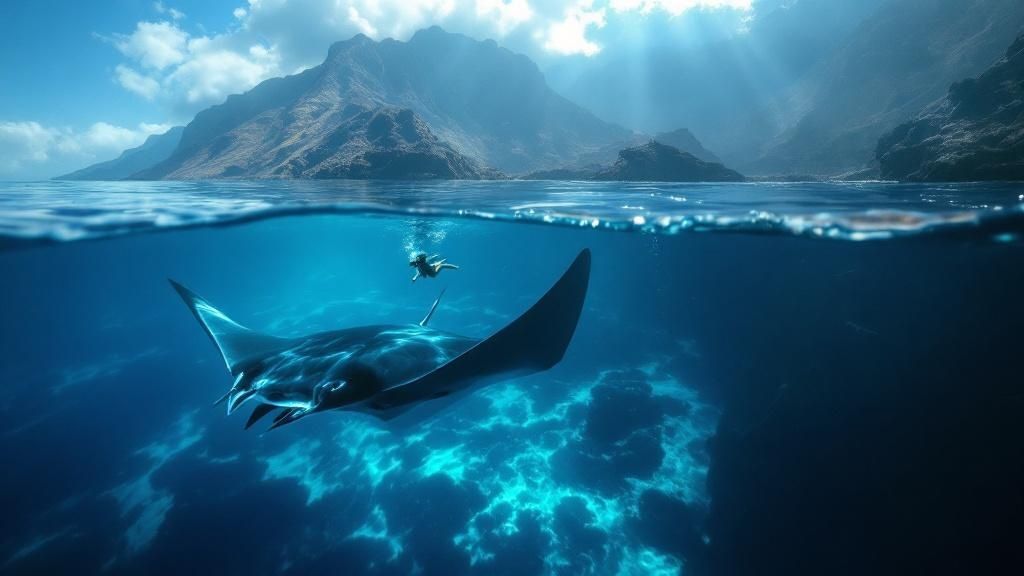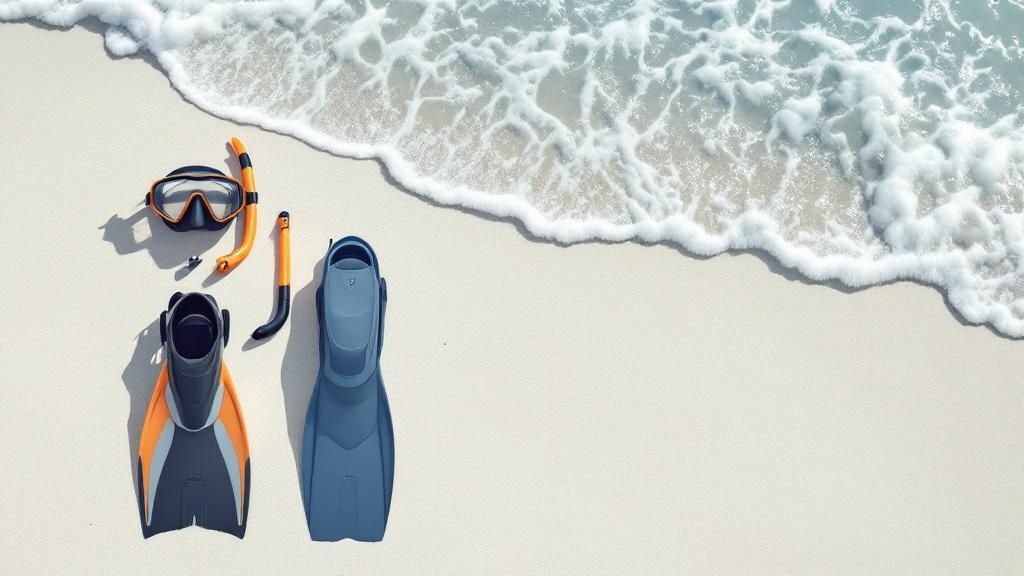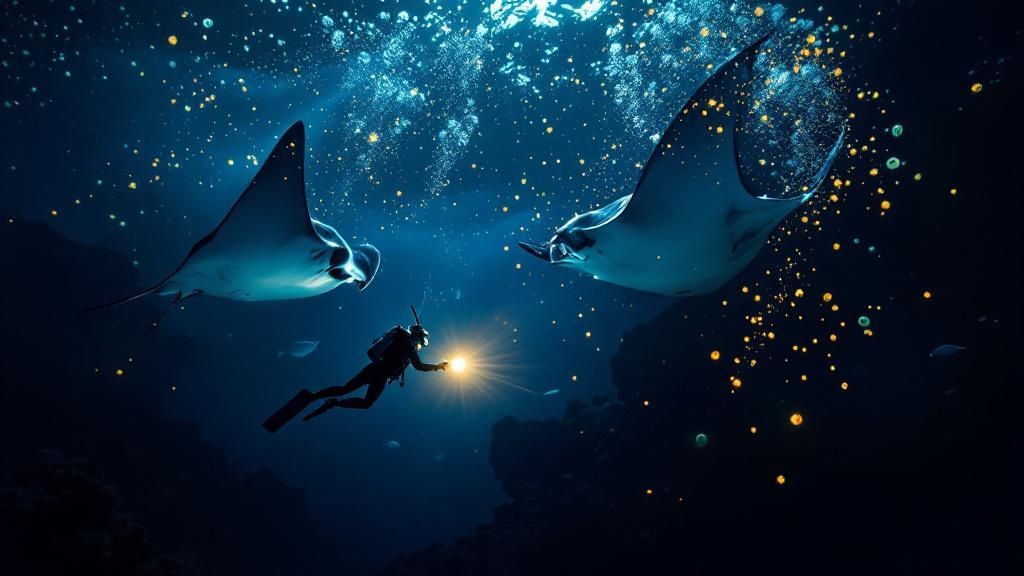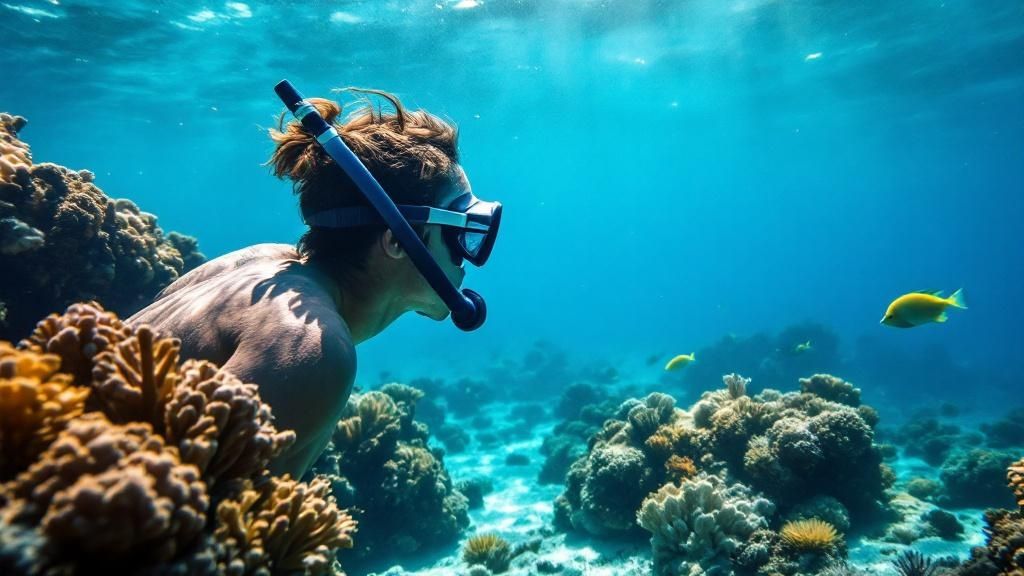Manta Ray Snorkel Kona: Experience Nighttime Encounters
- Byron
- Jun 4
- 12 min read
Why Kona Rules As The World's Manta Ray Capital
Kona, Hawaii, isn't just another tropical paradise with beautiful beaches. It's known as the manta ray capital of the world. This title isn't just clever marketing; Kona offers a unique combination of environmental factors that create the perfect habitat for these gentle giants. It's a truly special place for manta ray snorkel Kona experiences.
One key factor is Kona's nutrient-rich upwellings. These upwellings bring cold, nutrient-filled water from the ocean depths to the surface. This creates an ideal environment for plankton, the manta ray's main food source. The abundant plankton supports a complex and thriving ecosystem, giving mantas a readily available food supply. This encourages them to congregate in these waters.
Kona’s consistent water temperatures also make it attractive to manta rays. These stable temperatures contribute to the year-round presence of plankton. This, coupled with the unique underwater terrain, creates a perfect environment for manta ray feeding. Kona’s volcanic slopes form natural channels that funnel plankton upwards, concentrating the mantas' food source in predictable areas.
Kona boasts a thriving manta ray population estimated at over 450 individuals. This makes it one of the most stable and accessible populations to observe worldwide. The consistent water conditions allow for year-round snorkeling and diving. Night dives offer the best chances of seeing multiple manta rays. On average, three manta rays are spotted per dive, making for an incredible experience. The high concentration of mantas in Kona is due to the area's unique geological features, creating plankton-rich feeding grounds. This biodiversity, combined with local conservation efforts, has cemented Kona's reputation as the 'manta ray capital of the world'. Find more detailed statistics here
Conservation Efforts and Responsible Tourism
Beyond its ideal environmental conditions, Kona's dedication to conservation makes it stand out. Local communities and tour operators have adopted sustainable practices to minimize disruption to the manta rays' habitat. These efforts protect the manta rays while allowing visitors to experience these amazing creatures in their natural environment. Learn more in our article about Manta Ray Snorkel Kona: Hawaii’s Best Underwater Experience. You might be interested in: How to master....
The combination of ideal environmental conditions, reliable food sources, and dedicated conservation efforts explains Kona's status as the premier destination for manta ray encounters. It's a place where the wonders of nature and responsible tourism meet, creating a truly unforgettable experience.
What Are Your Real Chances Of Seeing Manta Rays?
Nobody wants to book an expensive tour only to be disappointed. So, what are your chances of seeing manta rays in Kona? The answer is excellent. Kona boasts some of the best odds on the planet, thanks to its unique environment.
Why Kona's Manta Ray Sightings Are So Reliable
Kona's reputation for manta ray sightings is well-deserved. Tour operators are often so confident, they offer guarantees. Why? It all comes down to the ideal conditions Kona offers these gentle giants. Nutrient-rich upwellings provide a constant supply of plankton, the manta rays' main food source. These upwellings, along with warm, clear waters, create a thriving plankton ecosystem, attracting mantas to predictable feeding areas.
The underwater terrain also plays a vital role. Sites like Manta Village and Manta Heaven act as natural amphitheaters. They concentrate the plankton and attract large numbers of manta rays, making these locations incredibly reliable for sightings. The success rate for spotting manta rays on night snorkeling trips in Kona is remarkably high, between 80% and 90%. This reliability draws approximately 80,000 snorkelers annually, making Kona a global hotspot for manta ray encounters. The combination of environmental factors and responsible tourism practices ensures visitors have a high probability of experiencing these magnificent creatures. Find more detailed statistics here
To better understand the seasonal variations in sighting success, take a look at the table below:
Manta Ray Sighting Success Rates by Season
Season | Success Rate (%) | Average Rays Per Trip | Best Viewing Times |
|---|---|---|---|
Spring (Mar-May) | 85-90 | 10-15 | After sunset |
Summer (Jun-Aug) | 90-95 | 15-20 | After sunset |
Fall (Sep-Nov) | 80-85 | 8-12 | After sunset |
Winter (Dec-Feb) | 75-80 | 5-10 | After sunset |
This table highlights the peak season for manta ray sightings, which is during the summer months. While sightings are still highly likely in other seasons, summer offers the highest success rates and the largest average number of rays per trip.
What Happens If the Mantas Don't Show?
While the odds are good, nature is unpredictable. Occasionally, even in Kona, the mantas don't appear. Reputable tour operators understand this and offer alternatives:
Re-booking: Most operators will let you re-book for free on another night.
Partial Refunds: Some may offer a partial refund if no mantas are sighted.
Alternative Tours: Some may offer a different snorkeling experience at another location.
This dedication to customer satisfaction, combined with the already high sighting rates, makes a manta ray snorkel Kona adventure truly unforgettable. It's a chance to glimpse the underwater world of these gentle giants.

The Ultimate Guide To Kona's Manta Ray Hotspots

Picking the right snorkel spot is crucial for an unforgettable manta ray experience in Kona. Not all locations are created equal! From the famous Manta Village to the exciting Manta Heaven, each site offers something unique.
Manta Village: The Original Hotspot
Manta Village, just south of Kona near the Sheraton Keauhou Bay Resort & Spa, is a classic for a reason. It boasts the highest success rate for manta ray sightings. Back in 2013, a whopping 96% of tours here reported seeing manta rays, with an average of four mantas per night. The shallow, sheltered bays create natural plankton traps, drawing in these graceful creatures. If you're staying near Keauhou Bay, some tour operators offer trips right from the bay, saving you travel time.
Manta Heaven: A Larger Gathering
North of Kona, off the Kona International Airport, lies Manta Heaven, sometimes called Garden Eel Cove. While its sighting success rate is slightly lower than Manta Village at 90%, the average number of manta rays seen per night is higher. In 2013, an average of 11 manta rays were seen per night here. This makes Manta Heaven a great option for those hoping to witness a larger gathering of these gentle giants.
Kohala Coast: A Less Crowded Option
Looking for a more personal experience? The Kohala Coast, near Waikoloa Village and the Kohala Resorts, is a less crowded choice. While fewer manta rays frequent this area compared to the other two, it offers a unique perk: less competition for the best viewing spots. You might even find your group is the only one in the water! This provides an amazing opportunity for close-up encounters.
To help you choose the perfect spot, here's a comparison table:
Top Kona Manta Ray Snorkeling Locations Comparison: This table provides a detailed comparison of the best manta ray snorkeling spots in Kona, including accessibility, ideal times, and experience level recommendations.
Location | Best Time | Depth | Experience Level | Average Manta Count (2013 Data) |
|---|---|---|---|---|
Manta Village | Night | Shallow | Beginner | 4 |
Manta Heaven | Night | Moderate | Intermediate | 11 |
Kohala Coast | Night | Varies | All Levels | Fewer than Manta Village/Heaven |
As you can see, each location has its own advantages and disadvantages. Manta Village offers the highest likelihood of a sighting, while Manta Heaven tends to have larger groups. The Kohala Coast is ideal for a quieter, more intimate experience.
Understanding Site Characteristics and Choosing the Right Spot
Each manta ray hotspot has its own distinct advantages:
Manta Village: Highest sighting success rate, ideal for beginners.
Manta Heaven: Larger groups of manta rays, leading to more exciting experiences.
Kohala Coast: Less crowded, offering more intimate interactions.
These differences highlight the importance of matching your snorkeling location to your preferences and expectations. Beginners might appreciate the reliability of Manta Village, while seasoned snorkelers seeking larger groups might choose Manta Heaven.
Understanding the underwater landscape also helps explain why mantas gather in these areas. Kona's volcanic slopes and ocean currents create predictable plankton-rich zones. These areas act like a dinner bell for the mantas. This knowledge of manta ray behavior and their preferred habitats is key to maximizing your snorkeling trip. Remember, experienced guides can interpret the conditions and offer valuable insights into where mantas are most likely to be found.
Night Vs. Day Snorkeling: When Magic Really Happens

Timing is key for a manta ray snorkel adventure in Kona. While daytime offers a glimpse into their world, the true magic unfolds after sunset. This is when the manta rays come together to feed, creating a remarkable spectacle.
The Allure of Night Snorkeling
Manta rays' feeding habits make nighttime the ideal viewing time. After dark, these majestic creatures gather at known feeding spots, attracted by plentiful plankton. Tour operators amplify this natural event with underwater lights. The lights attract even more plankton, creating concentrated food sources that draw in numerous manta rays. Think of it like a streetlight attracting moths—the lights used in manta ray night snorkeling similarly attract clouds of plankton.
This creates a surreal experience for snorkelers, floating on the surface in illuminated water surrounded by feeding manta rays. The gentle giants perform elegant acrobatics as they filter the plankton, an unforgettable sight. Night snorkeling virtually guarantees an opportunity to see manta rays in action. Learn more in our article about Manta Ray Night Snorkel Kona: An Epic Hawaiian Tour.
Challenges and Rewards of Nighttime Adventures
Night snorkeling does have its challenges. The darkness can be intimidating for some. However, reputable tour operators prioritize safety with thorough briefings and experienced guides. They ensure everyone is comfortable and properly equipped.
Specialized equipment is also necessary for night snorkeling. Wetsuits are essential for warmth, and many operators provide them. A good mask and snorkel are crucial for clear vision, and underwater lights enhance the viewing experience.
The rewards of night snorkeling far outweigh any challenges. Observing these incredible creatures up close in their natural habitat is truly inspiring. The illuminated water, the graceful manta rays, and the sense of wonder create a lasting memory. This makes nighttime manta ray snorkeling one of the most memorable wildlife encounters you can experience.
The Magic of Daytime Sightings
Though less frequent, daytime manta ray encounters have their own unique charm. These sightings offer a different perspective. Without the nighttime feeding frenzy, you may see individual manta rays or smaller groups, allowing you to appreciate their size and markings.
Daytime sightings depend on certain conditions. Water clarity and the presence of surface plankton affect the likelihood of a sighting. But these chance encounters offer a special reward. The contrast of the manta rays' dark bodies against the bright sunlight creates stunning visuals. It's a reminder of the unpredictable beauty of nature.
Getting To Know Your Swimming Partners

Swimming with manta rays in Kona is a truly special experience. But understanding these magnificent creatures beforehand can make the encounter even richer. It goes beyond just the initial thrill; each manta ray has its own personality, intricate social behaviors, and fascinating biology.
Manta Ray Biology and Behavior
Manta rays are incredibly intelligent. They are members of the elasmobranch family, which makes them relatives of sharks and rays. These gentle giants are filter feeders, meaning their diet consists of microscopic plankton. This is why they're drawn to the plankton-rich waters of Kona. Their cephalic fins, positioned on both sides of their mouths, help guide the plankton inwards.
Manta rays also exhibit complex social interactions. They frequently gather at cleaning stations, where smaller fish help remove parasites and dead skin. This cooperative behavior reveals a surprising level of social intelligence. They're also known for playful actions, sometimes breaching the surface or performing barrel rolls. Witnessing this on a manta ray snorkel Kona trip is truly remarkable.
Research and Conservation in Kona
Kona is a center for cutting-edge manta ray research. Scientists track individual mantas to study their migration routes, what they eat, and how they socialize. Each manta has distinctive markings on its underside, which makes it possible for researchers to identify and catalog them. This research is essential for understanding these animals and creating successful conservation plans.
Manta ray sightings in Kona are carefully documented, providing important information for both research and conservation. Organizations such as Manta Ray Advocates Hawaii keep comprehensive records of manta ray sightings going back to 2009. This data reveals important insights into how often manta rays are encountered and the patterns of these encounters along the Kona Coast. Understanding their habits and preferred habitats is key. It also helps tourists know the best times and places to see these magnificent creatures. Find more detailed statistics here. Kona's dedication to responsible tourism and manta ray conservation is evident in its dedication to data collection.
Responsible Tourism and Its Impact
Responsible tourism is vital for the well-being of manta rays. Tour operators in Kona follow strict rules to minimize disruptions to these gentle creatures. These include keeping a safe distance, never touching the mantas, and only using red lights during night snorkeling. These practices help ensure that human interaction doesn't harm the manta ray population.
Many tour operators also take an active role in conservation. They educate their clients about manta rays, provide support for research initiatives, and contribute to local organizations working to protect the animals. By selecting a responsible tour operator for your manta ray snorkel Kona adventure, you directly contribute to the preservation of these creatures for years to come.
The Unique Personalities of Manta Rays
Although manta rays may seem similar at first glance, each one has a unique personality. Some are curious and playful, engaging with snorkelers. Others are shyer, preferring to observe from a distance. Recognizing these individual differences enriches the encounter. It transforms the experience from simply observing wildlife to a deeper connection with individual animals.
Choosing Your Tour Operator Like a Pro
With so many tour operators offering manta ray snorkel Kona experiences, finding the right one can be a challenge. Knowing what makes a truly great tour can be the difference between a memorable adventure and a so-so trip. This guide will help you choose wisely. We'll cover important factors like safety, conservation, group size, and success rates.
Key Factors for Choosing a Tour Operator
Safety should always come first. Look for operators with strong safety records and certified lifeguards as guides. It's also good to consider their commitment to conservation. Responsible operators follow strict wildlife interaction rules and support local conservation work.
Group size matters too. Smaller groups mean more individual attention from guides and less disruption to the manta rays. Larger groups can be fun, but also feel crowded, especially at popular spots. Think about what's comfortable for you when deciding between small group tours and larger ones. For more on Kona tours, check out our guide: Manta Ray Snorkel Kona: Top 2025 Tours.
Success rates are also important. While no one can guarantee manta ray sightings 100%, good companies in Kona often have high success rates, sometimes over 90%. This is thanks to their knowledge of manta ray behavior and the local environment.
Questions to Ask and Red Flags to Avoid
Don't be afraid to ask potential tour operators questions. Ask about safety procedures, conservation efforts, group size limits, and what happens if no mantas appear. Do they offer re-booking or partial refunds?
Watch out for operators who make unrealistic promises or encourage harmful practices, like touching or chasing the manta rays. These are definite red flags. A responsible operator cares about the manta rays and follows ethical guidelines.
Different Tour Formats
Understanding the different tour types can help you choose the right one. Some tours are at sunset, while others are after dark. Some combine manta ray snorkeling with other activities, like visiting Captain Cook Bay. Consider what fits your interests and schedule. By weighing these factors and asking the right questions, you can choose a tour operator for a safe, educational, and memorable manta ray snorkel Kona experience.
Your Pre-Adventure Success Checklist
Preparing for your manta ray snorkel Kona adventure is essential for a truly memorable experience. The difference between a good trip and an amazing one often hinges on preparation. This checklist covers everything from gear to mindset.
Essential Gear: Ensuring Comfort and Clarity
The right gear can significantly improve your manta ray experience. Properly fitted masks are crucial for clear underwater vision. Test your mask beforehand to ensure a snug fit and prevent leaks. Fins designed for Hawaiian waters will help you move easily. Think about water temperature when choosing a wetsuit. Although Kona waters are usually warm, a wetsuit offers additional warmth, especially during longer night snorkeling excursions. Remember, some tour operators provide these items, allowing you to pack lighter.
Here's a quick gear checklist:
Mask and Snorkel: Make sure they fit correctly and are in good working order.
Fins: Opt for fins designed for snorkeling, not diving.
Wetsuit (optional): A 3mm wetsuit is suitable for warmer months, while a 5mm wetsuit is better for cooler times.
Underwater Camera: A GoPro or similar camera is great for capturing memories. Red filters can improve daytime underwater photos.
Towel and Dry Clothes: Dry clothes to change into are a necessity.
Seasickness Remedies: If you are prone to seasickness, bring medication or acupressure bands.
Preparing for the Unexpected: Seasickness and Anxiety
Many first-time snorkelers experience seasickness or anxiety, particularly during night trips. For seasickness, over-the-counter medications or acupressure wristbands can provide relief. Some operators offer larger, more stable boats that minimize movement. A shorter boat ride to the snorkeling site, such as from Keauhou Bay to Manta Village, can also help reduce seasickness triggers.
If you're anxious about night snorkeling, talk to your tour guide. They can offer support and reassurance. Focusing on your breathing can help manage anxiety. Remember, the guides are trained professionals dedicated to providing a safe and enjoyable experience.
Mental Preparation and Managing Expectations
Mental preparation is as important as having the right gear. While Kona has excellent manta ray sighting rates, between 80% and 90%, nature is always unpredictable. Manta rays are wild animals; sightings are not guaranteed. Many reputable operators offer free re-booking or partial refunds if no mantas are seen, so be sure to ask about their policies when booking. Understanding this lets you enjoy the overall experience, no matter how many manta rays you encounter. Even without a sighting, the beauty of Kona's nighttime waters is an adventure in itself.
Book your unforgettable manta ray night snorkel adventure today with Manta Ray Night Snorkel Hawaii!
Comments